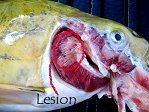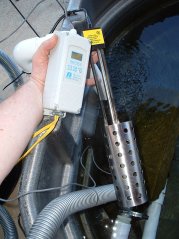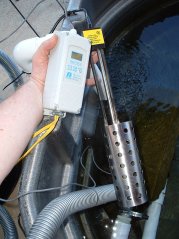Koi Herpes Virus KHV Cured or Treated
This article is dedicated to my personal friends, Brenda and Charlie Atwell, whose pond contracted KHV and was essentially wiped out, after re-introducing some fish which were returned to them, after a breeding-loan.
The koi hobby has been rocked by a fearsome virus which everyone seems to be getting with their new fish lately. [2003 summer] This virus has been reported in Israel and among Japanese fish, but has so far not been diagnosed in its current form in Japan. There are active cases (and a few dealers) now in California, Ohio, Louisville, Atlanta, Chicago, New York, Indiana, Nevada, Arizona, Texas, Virginia, and Florida.
Koi Herpes Virus KHV Cured or Treated
KHV Controlled! (Playing with Fire) – by Dr. Erik L. Johnson
Koi Herpes Virus
Understanding this virus, and what you can do to save your fish, is the intention of this document. It is EASY to save your fish from this virus with heat, at 87 degrees F – if you are prepared, educated, and act fast!!!

Koi Herpes Virus is a virus infecting Koi which selectively penetrates and annihilates the epidermal cells of the koi, stripping the gills and skin and leaving them extremely vulnerable to secondary infection by Aeromonas and other fish bacterial pathogens. Most folks report almost total loss of their fish within 10-14 days, but it doesn’t have to be that way.
At left, a Midori with typical gill lesions of KHV
Because of the way the virus works, the fish appear to be burned on the outside, or excessivly slimey as it’s skin fights the virus. The damage to the gills is usually worse.
Typical Symptoms:
- Head down swimming
- Lethargy and weakness
- Sunken eyes
- GILL LESIONS!!!
- Sandpaper skin
- White stringy slime on the skin
- Eventual dark discoloration in certain surviving fish
- Body sores
Koi herpes virus doesn’t ALWAYS have to appear as mass-mortality (death) and wide scale infection. A case has recently come about that tipped us off to the fact that under the right circumstances, KHV outbreaks can look like routine Aeromonas ulcer cases with 10-20% morbidity. Losses (mortalities) in the case I am referring to were only 7-8% Additionally, losses in this particular case were completely stopped by heating the groups of fish to 87 degrees F.
Here’s a response from another person whose fish were heated to recovery:
“…I am done with the 3 day @ 87df. The koi that I sent you a picture of responded very well. Her back has kind of crusted over as well as some of the other very sick ones. I also heated up my 1,600 gal. facility. I have not had any more die with the sunken eye and sandpaper scales! (Although I have had some losses in small koi). Have you ever seen the koi change color under these temps ? I have one that lost her tancho, and a Sora-goi that went from a light grey to a very dark blue-grey.”
Gill lesions are the safest clinical symptom to associate with KHV. What you would EXPECT to see are fish with red gills, however, there would be white patches or streaks in the gill tissue. Several recent cases however, had no gill lesions at all.
Diagnosis of Koi Herpes Virus can be undertaken via laboratories which are set up to perform PCR testing. This is “Polymerase Chain Reaction” testing in which tissues are homogenized and then a probe is used to find tiny bits of the virus DNA. This test can “miss” DNA particles which are present and in a good number of cases, there’s not enough DNA to find. So false NEGATIVES may occur. However, when the test is positive, against the proper controls*, it cannot be a false positive.
*Some authorities are not using positive or negative controls and may be less careful about the preparation of the DNA probes. Cross reactions and false positives may occur.
How to get the diagnosis: Using a lab which is capable of performing the PCR test for KHV, you are well-advised to send at least three fish for PCR testing. For best results, these test-specimens would arrive alive at the lab, shipped overnight in good water, under pure oxygen.
I have not seen a suspect-case yet which had sent three fish in which at least one fish was negative. This means that in groups of known-positive KHV infection, you have a one-or-two out of three chance of actually finding it. This is because the virus has a peak in its production during an epidemic (reportedly day #4-9) and when that peak is missed within a particular fish, then the fish is likely to test negative even though the virus is, or has been infecting that host.
Always send more than one fish, because among a group, there will be false negatives.
How Common is KHV?
KHV is extremely common. There are three reasons for this.
Hosts can carry the virus until the fish becomes vulnerable and the virus replicates. Therefore, fish can be sold “appearing healthy”, only to infect itself and other fish when conditions are ‘right’.
Dealers have started to understand that heating the fish to 86-87d F seems to salvage most of the infected fish and have intercepted alot of these cases early, before testing is done. Recovered fish may be sold, and, while we do not know this, recovered fish may be a source of infection.
There is a strain of KHV which has a low-mortality clinical appearance, in which most of the fish which are infected seem to resist this strain and can be sold after what appears to be a “garden variety” Aeromonas sores outbreak.
What Can Be Done About KHV Outbreaks?
This depends upon who you are. If you are a regulatory agency or epidemiologist, you might suggest destruction of all the fish affected to limit spread. This, however, would be a shame because you would end up destroying HALF the fish being sold in the USA right now. If a dealer were to destroy his infected livestock, he would be doing so while more than half the dealers in the industry bury the problem and continue to sell. Most of these, because they refuse to test even the fish with symptoms.
For example, Pam Kinkade bought fish from Barstow Koi and another koi retailer, both located in Newberry Springs, California. All her fish summarily broke with KHV and before she was able to heat the fish, she lost most of them.
She contacted the two dealers, and (I think this is VERY honorable) Ken Liu of Barstow Koi immediately sent five fish to University of Georgia for complete necropsy and KHV testing. The fish came back NEGATIVE. No virus. Ken Liu of Barstow deserves commendation.
The other dealer in Newberry Springs California flatly refused to have testing done. Therefore, unless hobbyists are prepared to heat, and to heat quickly, they will buy from this type of dealer, and therefore stand to lose all their fish to KHV.

Since, as I have illustrated, not all dealers exhibit ‘due diligence’ when confronted with this virus, HOBBYISTS are going to have to be ready to handle it when their fish develop this disease.
The best defense against KHV is a lengthy quarantine. In quarantine; heat, salt and Prazipro could be recommended but nothing but extended time can really exclude the virus.
The best defense against KHV is a lengthy quarantine.
In an outbreak – HEAT IS CURATIVE of the symptoms, (not necessarily the virus) but there are numerous difficulties.
Heating Drawbacks
- Heat accelerates parasite proliferation
- Heat accelerates bacterial pathogens
- Heat reduces available oxygen for the fish
- Heating large facilities is not ‘easy’ or quickly accomplished.
- After heating, these healthy looking survivors may still carry the virus.
For the hobbyist – when beloved fish matter:
I have saved just about every KHV fish I have been shipped by employing high heat and medicated food. Sometimes a person really loves a particular fish, or particular group of fish, so letting them all die is not a pleasant option. By heating, a person can save most of their affected fish, and continue to enjoy the collection as a closed “KHV Positive” collection. One advantage is that you can get all the free fish you want from the hundreds of cases across the USA – if you simply offer to give the survivors a home.
Heating fish has its drawbacks.
You must understand that if you heat a bacterial infection, the bacterial pathogen gets a metabolic advantage and accelerates its destructive path. The same is true for parasites. When you heat certain (if not most) parasites, they get a metabolic boost and proliferate explosively. So, if you blindly heat groups of fish to curb the obvious or latent KHV infection, you risk heating up another problem. But there are solutions to this quandary. Simply treating bacterial infections in the Qtank as you heat tends to limit the problem of accelerating a bacterial issue. Also, developing superior “shotgun” parasite regimens in heated facilities, or better still, using a microscope in these facilities, will prevent you from boosting a parasitic outbreak.
If you can diagnose or create a scenario without parasitic or bacterial threats, you are in a good position to “heat out” the KHV which may be carried by a group of fish, but there are two other variables.
Heating lots of water isn’t easy.
When you heat thousands of gallons of water like I do, you should consider using a powerful gas water boiler. I use propane in my indoor-outdoor water heater, and pass the super heated water through an exchanger which gives the heat to the pond water, without risking discharge of hazardous metals into the water. When your water heater circulates directly with your pond, the risk of pipe burst and discharge of contaminated water is great. So heat exchangers are recommended.

If you’re heating a little water, Qtanks (collapsible show tanks) and tubs work well. Never heat a fish in less than a hundred gallons unless the fish or fishes are truly tiny. In some cases, if not many cases, a person is faced with the spectacle of being unable to heat all their fish, so they bring several beloved specimens to safety in a hospital tank, heat them to 87 degrees Fahrenheit, and watch as the rest die outside, unheated.
The bucketwarmers shown above are forty dollars ar most tool rentals, painting supply places, or Lowe’s. They can be variable in their power. The ones shown are 1500 Watts each. They occur in wattages up to 2000 Watts. As a rule of thumb, against a low outdoor temperature in a semi-insulated tub or vat, you would need one thousand Watts per two hundred gallons in order to achieve and maintain sufficient heat.
The thermostat is a Ranco Nema 4X Indoor Outdoor thermostat and is available from Amazon.
Wiring the paint bucket warmers to the thermostat is as easy as the diagram, but if you want to preserve the relative safety of having a “ground” (reduces chances of being electrocuted, which is a good thing), you will probably need an electrician to help you bypass the thermostat with the ground lead and let the thermostat just have the hot wires.
The second variable is the fact that warm water carries less oxygen, so while the fish are being pounded in the gills by this virus, they have less luck with breathing. Then, you get brilliant and start heating them up, further depriving them of oxygen for exchange. I respond thusly: If you don’t heat them, they’re goners. If you do heat them, expect some mortalities as the ones with the worst gills, and worst bacterial infections simply die.
Aeration in the heating facilities is SO VERY important! I prefer to use a water pump, set on it’s side on the tank bottom. The discharge is aiming upward at the water surface. Done correctly, the surface of the tank will show a swell or slight floom as the water meets the surface and glides outward towards the tank sides and back down again. If you have the pump so powerful that the water ‘geysers’ upward, that’s great – but it’s your butt when the house mildews or the splattering geyser tips out of the tank onto the floor. [This happens the instant you head out to the store]
Here are the basic steps to rapid heating fish:
As much as possible, determine if the fish have KHV by sending one or more to a lab for testing.
As much as possible, prevent parasitic acceleration with salt at 0.3 to 0.6 percent
As much as possible, prevent bacterial acceleration by injection of antibiotics, medicated food, Tricide dips* (once the fish are more stable) or some other method.
(*Tricide is off the market I think.)
Fill your intended quarantine or hospital system with water from the main system. If the water is icy cold, you will need it to achieve room temperature under its own power (without agitation or artificial heat sources) before applying any electric or other heat. If the water from the pond is already in the mid fifties or higher, accelerate the heating process at once.
Add pH support (carbonates) to the water as the fish will put a drain on the pH and you don’t want it to crash. (1 tablespoon of baking soda in 100-200 gallons as needed)
Floom, or aggressively-aerate the tank
Begin heating in order to achieve at least ten degrees in 12 hours or twenty degrees in 24 hours. I have warmed fish faster. I have seen fish coming inside from ice water which could not handle that. With the Bergman fish, they arrived at 54d F and were at 87d F within 36 hours. Again, time is of the essence and aeration will help alot with your heating troubles.
Fish should improve when they achieve 83d F but they will be ‘cured at 87d F. They should be held at that temperature for at least four days before cooling them off. I say at LEAST because they seem to do so well when warmed and they need every break they can get.
So, you saved your fish, what do you do with these survivors? Is it worth the pond keeping experience for ‘the remains’ of your former collection? Is it safe to get new fish? Can you show these fish?
When you save your fish from KHV, it raises all these questions.
I think people should save the survivors. How do you know that you’re not going to go out, after killing off the stragglers, and buy new KHV infected fish? In the current climate, you do not know this. So you could kill the fish with names, just to repopulate with fish which could put you through this all over again!
I think keeping a smaller group of survivors has it’s advantages in terms of their eventual growth. Underpopulated ponds are healthier, and the fish grow much larger in less time.
There are at least two ways to get new fish. You can heat the pond, and get all the new fish you want as long as the new fish are prepared for, acclimated to, and mixed at 87d F. I have mixed KHV and non KHV fish in a variety of circumstances and had ZERO transmission:
KHV post-heat survivors seem to be non infectious to other fish. I have mixed healthy non-exposed fish with post-heat KHV survivors at normal pond and tank temperatures without disease. It’s AS IF the post heat KHV survivors are cured. We don’t know this for sure so this might be the most risky way to get new fish.
SAFE: Actively infected fish can be added to healthy populations of fish as long as the pond or tank is maintained (for the minimum four to seven day period) at 87d F. I accidentally did this twice, and have done it intentionally many more times since. It was not until we got the KHV reports back that I discovered I’d added some KHV positive fish to healthy tanks. Since the tanks were at 87d F there was no transmission.
There are quite a few people who have mixed new fish in with their KHV survivors and NONE of them report any losses among the new fish. Now, that might be an issue for this year, and the statistic could change after a long cold winter. It could also be that the KHV survivors are truly negative, by either innate immunity or the heating process which might have saved them, or both. The jury is still out on that one.
I don’t think a person who knows they have KHV survivors or KHV infected fish should take them to shows. The only reason so many people and dealers take KHV infected fish to shows is because they don’t know the fish have KHV. YET.
I have a growing collection of “post-heat KHV survivors” at my home. I think they are great fish and they’ve been nothing less than perfectly healthy. When I want to add new fish, I simply heat the pond to a whopping 87d F and then add the intended new fish*. This is what it ‘is’ to be KHV infected in the aftermath. And I can live with it, happily.
*after a short quarantine and biopsy.






